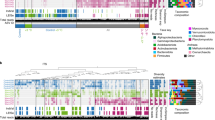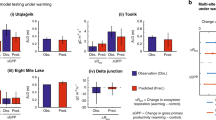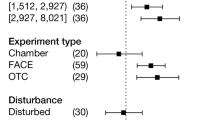Abstract
Attempts to understand the ecological effect of increasing atmospheric CO2 concentration, [CO2], usually involve exposing today's ecosystems to expected future [CO2] levels1,2. However, a major assumption of these approaches has not been tested—that exposing ecosystems to a single-step increase in [CO2] will yield similar responses to those of a gradual increase over several decades3. We tested this assumption on a mycorrhizal fungal community over a period of six years. [CO2] was either increased abruptly, as is typical of most [CO2] experiments, or more gradually over 21 generations. The two approaches resulted in different structural and functional community responses to increased [CO2]. Some fungi were sensitive to the carbon pulse of the abrupt [CO2] treatment. This resulted in an immediate decline in fungal species richness and a significant change in mycorrhizal functioning. The magnitude of changes in fungal diversity and functioning in response to gradually increasing [CO2] was smaller, and not significantly different to those with ambient [CO2]. Our results suggest that studies may overestimate some community responses to increasing [CO2] because biota may be sensitive to ecosystem changes that occur as a result of abrupt increases.
This is a preview of subscription content, access via your institution
Access options
Subscribe to this journal
Receive 51 print issues and online access
$199.00 per year
only $3.90 per issue
Buy this article
- Purchase on Springer Link
- Instant access to full article PDF
Prices may be subject to local taxes which are calculated during checkout


Similar content being viewed by others
References
Körner, C. & Bazzaz, F. A. Carbon Dioxide, Populations, and Communities (Academic Press, San Diego, 1996)
Luo, Y. & Mooney, H. A. Carbon Dioxide and Environmental Stress (Academic Press, San Diego, 1999)
Luo, Y. & Reynolds, J. F. Validity of extrapolating field CO2 experiments to predict carbon sequestration in natural ecosystems. Ecology 80, 1568–1583 (1999)
IPCC. Climate Change 2001: Synthesis Report. in A Contribution of Working Groups I, II, and III to the Third Assessment Report of the Intergovernmental Panel on Climate Change (eds Watson, R. T. & the core writing team) 1–398 (Cambridge Univ. Press, Cambridge, 2001)
Bazzaz, F. A. The response of natural ecosystems to the rising global CO2 levels. Annu. Rev. Ecol. Syst. 21, 167–196 (1990)
Ward, J. K. & Kelly, J. K. Scaling up evolutionary responses to elevated CO2: lessons from Arabidopsis . Ecol. Lett. 7, 427–440 (2004)
Sinead, C. & Bell, G. Phenotypic consequences of 1,000 generations of selection at elevated CO2 in a green alga. Nature 431, 566–569(2004)
Rillig, M. C., Treseder, K. K. & Allen, M. F. in Mycorrhizal Ecology (eds van der Heijden, M. G. A. & Sanders, I.) 135–160 (Springer, Berlin, 2002)
Treseder, K. K. A meta-analysis of mycorrhizal responses to nitrogen, phosphorus, and atmospheric CO2 in field studies. New Phytol. 164, 347–355 (2004)
Staddon, P. L. & Fitter, A. H. Does elevated atmospheric carbon dioxide affect arbuscular mycorrhizas? Trends Ecol. Evol. 13, 455–458 (1998)
Allen, M. F. Ecology of Mycorrhizae (Cambridge Univ. Press, Cambridge, 1991)
Smith, S. E. & Read, D. J. Mycorrhizal Symbioses 2nd edn (Academic, London, 1997)
Klironomos, J. N., Ursic, M., Rillig, M. & Allen, M. F. Inter-specific differences in the response of arbuscular mycorrhizal fungi to Artemisia tridentata grown under elevated atmospheric CO2 . New Phytol. 138, 599–605 (1998)
Treseder, K. K., Egerton-Warburton, L. M., Allen, M. F., Cheng, Y. & Oechel, W. C. Alteration of soil carbon pools and communities of mycorrhizal fungi in chaparral exposed to elevated carbon dioxide. Ecosystems 6, 786–796 (2003)
Wolf, J., Johnson, N. C., Rowland, D. L. & Reich, P. B. Elevated CO2 and plant species richness impact arbuscular mycorrhizal fungal spore communities. New Phytol. 157, 579–588 (2003)
Klironomos, J. N. Variation in plant response to native and exotic arbuscular mycorrhizal fungi. Ecology 84, 2292–2301 (2003)
Klironomos, J. N. in Microbial Biosystems: New Frontiers (eds Bell, C. R., Brylinsky, M. & Johnson-Green, P.). 845–851 (Proc. 8th Int. Symp. on Microbial Ecology, Halifax, 2000).
Hart, M. M. & Reader, R. J. Taxonomic basis for variation in the colonization strategy of arbuscular mycorrhizal fungi. New Phytol. 153, 335–344 (2002)
Rillig, M. C., Wright, S. F., Allen, M. F. & Field, C. B. Rise in carbon dioxide changes soil structure. Nature 400, 628 (1999)
Piotrowski, J. S., Denich, T., Klironomos, J. N., Graham, J. M. & Rillig, M. C. The effects of arbuscular mycorrhizae on soil aggregation depend on the interaction between plant and fungal species. New Phytol. 164, 365–373 (2004)
Van der Heijden, M. G. A. et al. Mycorrhizal fungal diversity determines plant biodiversity, ecosystem variability and productivity. Nature 396, 69–72 (1998)
Goverde, M., Van der Heijden, M. G. A., Wiemken, A., Sanders, I. R. & Erhardt, A. Arbuscular mycorrhizal fungi influence life history traits of a lepidopteran herbivore. Oecologia 125, 362–369 (2000)
Gange, A. C., Brown, V. K. & Alphin, D. M. Multitrophic links between arbuscular mycorrhizal fungi and insect parasitoids. Ecol. Lett. 6, 1051–1055 (2003)
Rillig, M. C. Arbuscular mycorrhizae and ecosystem processes. Ecol. Lett. 7, 740–754 (2004)
Brundrett, M. C., Piché, Y. & Peterson, R. L. A new method for observing the morphology of vesicular-arbuscular mycorrhizae. Can. J. Bot. 62, 2128–2134 (1984)
McGonigle, T. P., Miller, M. H., Evans, D. G., Fairchild, G. L. & Swan, J. A. A new method which gives an objective measure of colonization of roots by vesicular-arbuscular mycorrhizal fungi. New Phytol. 115, 495–501 (1990)
Miller, R. M., Reinhardt, D. R. & Jastrow, J. D. External hyphal production of vesicular-arbuscular mycorrhizal fungi in pasture and tallgrass prairie communities. Oecologia 103, 17–23 (1995)
Kemper, W. D. & Rosenau, R. C. in Methods of Soil Analysis Part 1. Physical and Mineralogical Methods 2nd edn (ed. Klute, A.) 425 (Agronomy Monograph No. 9, American Society of Agronomy, Madison, 1986)
Acknowledgements
We thank T. Crouch, T. Denich, P. Jermaine, P. John, B. Kerin, G. Lefebre, J. McCune, P. Moutoglis, J. Neville, V. Ortega, Y. Sipos-Randor, F. Steele, V. Turner, D. Wollad, E. Young and V. Yu for technical assistance. Financial support for this project was provided by a grant to J.N.K. by the Natural Sciences and Engineering Research Council of Canada, to M.F.A. by the US Department of Energy, and to M.C.R. by the US National Science Foundation.
Author information
Authors and Affiliations
Corresponding author
Ethics declarations
Competing interests
The authors declare that they have no competing financial interests.
Rights and permissions
About this article
Cite this article
Klironomos, J., Allen, M., Rillig, M. et al. Abrupt rise in atmospheric CO2 overestimates community response in a model plant–soil system. Nature 433, 621–624 (2005). https://doi.org/10.1038/nature03268
Received:
Accepted:
Issue Date:
DOI: https://doi.org/10.1038/nature03268
This article is cited by
-
Will free-living microbial community composition drive biogeochemical responses to global change?
Biogeochemistry (2023)
-
Effects of elevated CO2 concentration on CH4 and N2O emissions from paddy fields: A meta-analysis
Science China Earth Sciences (2022)
-
Transgenerational effects of elevated CO2 on rice photosynthesis and grain yield
Plant Molecular Biology (2022)
-
Competition alters species’ plastic and genetic response to environmental change
Scientific Reports (2021)
-
Unraveling the AM fungal community for understanding its ecosystem resilience to changed climate in agroecosystems
Symbiosis (2021)
Comments
By submitting a comment you agree to abide by our Terms and Community Guidelines. If you find something abusive or that does not comply with our terms or guidelines please flag it as inappropriate.



